A 150-million-year-old dinosaur skeleton is displayed at the Natural History Museum’s new welcome center currently under construction Tuesday, July 2, 2024 in Los Angeles. The newest resident is a large, green, 150-million-year-old, 75-foot green dinosaur named Gnatalie that will be available for public viewing in the fall at the museum. Research believes that Gnatalie (pronounced Natalie) is a member of a new species of sauropod, a long-necked dinosaur that lived 150 million years ago in the late Jurassic era. Credit: AP Photo/Richard Vogel
The latest dinosaur mounted at the Natural History Museum in Los Angeles is not only a member of a new species, but is also the only one found on the planet whose bones are green, according to museum officials.
Named “Gnatalie” (pronounced Natalie) for the mosquitoes that swarmed during the excavation, the fossils of the long-necked, long-tailed herbivorous dinosaur got its unique color, a dark mottled olive green, from the mineral celadonite during the fossilization process. .
While fossils are usually brown from silica or black from iron minerals, green is rare because celadonite forms under volcanic or hydrothermal conditions that usually destroy buried bones. Celadonite became fossilized when volcanic activity about 50 million to 80 million years ago made it hot enough to replace an earlier mineral.
The dinosaur lived 150 million years ago in the late Jurassic period, making it older than Tyrannosaurus rex – which lived 66 million to 68 million years ago.
Researchers discovered the remains in 2007 in the Utah Badlands.
“Dinosaurs are a great tool to teach our visitors about the nature of science, and what better way to engage them in the process of scientific discovery and make them they reflect on the wonders of the world we live in!” Luis M. Chiappe of the museum’s Dinosaur Institute said in a statement about his team’s discovery.
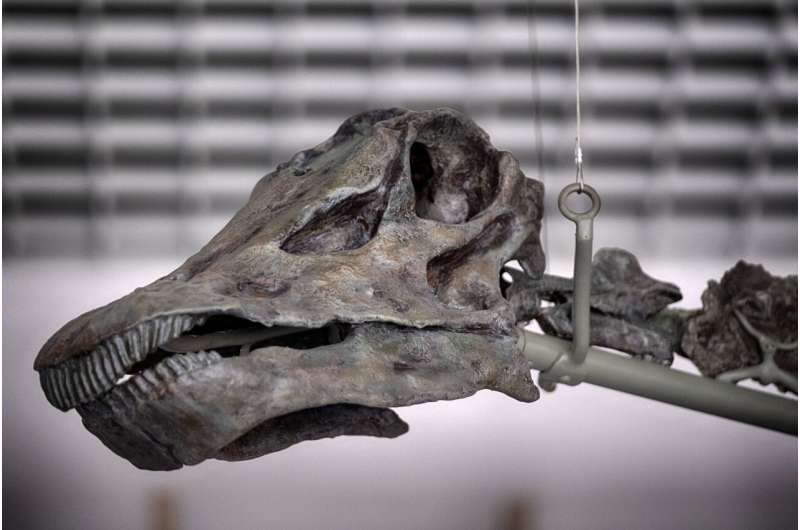
The skull of a 150-million-year-old dinosaur is displayed at the Natural History Museum’s new welcome center currently under construction Tuesday, July 2, 2024, in Los Angeles. The newest resident is a large, green, 150-million-year-old, 75-foot green dinosaur named Gnatalie that will be available for public viewing in the fall at the museum. Research believes that Gnatalie (pronounced Natalie) is a member of a new species of sauropod, a long-necked dinosaur that lived 150 million years ago in the late Jurassic era. Credit: AP Photo/Richard Vogel
Matt Wedel, an anatomist and paleontologist at Western University of Health Sciences in Pomona near Los Angeles, said he heard “rumors of a green dinosaur very early on when I was in graduate school.”
When he looked at the bones while they were still being cleaned, he said they were “like nothing else I’ve ever seen.”
The dinosaur is similar to a species of sauropod called Diplodocus and the discovery will be published in a scientific paper next year. The sauropod, referring to a massive herbivorous family that includes Brontosaurus and Brachiosaurus, will be the largest dinosaur at the museum and can be seen this fall in the new welcome center.
John Whitlock, who teaches at Mount Aloysius College, a private Catholic college in Cresson, Pennsylvania, and researches sauropods, said it was exciting to have such a complete skeleton to help fill in the gaps for less well-known specimens. full.
-
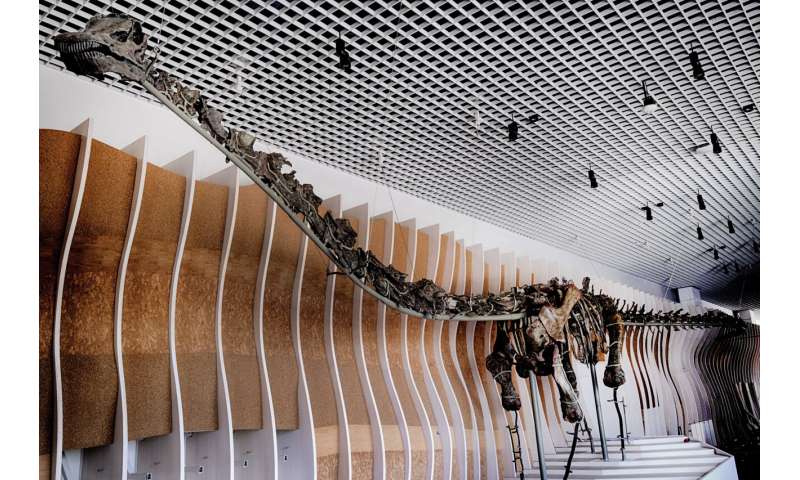
A 150-million-year-old dinosaur skeleton is displayed at the Natural History Museum’s new welcome center currently under construction Tuesday, July 2, 2024 in Los Angeles. The newest resident is a large, green, 150-million-year-old, 75-foot green dinosaur named Gnatalie that will be available for public viewing in the fall at the museum. Research believes that Gnatalie (pronounced Natalie) is a member of a new species of sauropod, a long-necked dinosaur that lived 150 million years ago in the late Jurassic era. Credit: AP Photo/Richard Vogel
-
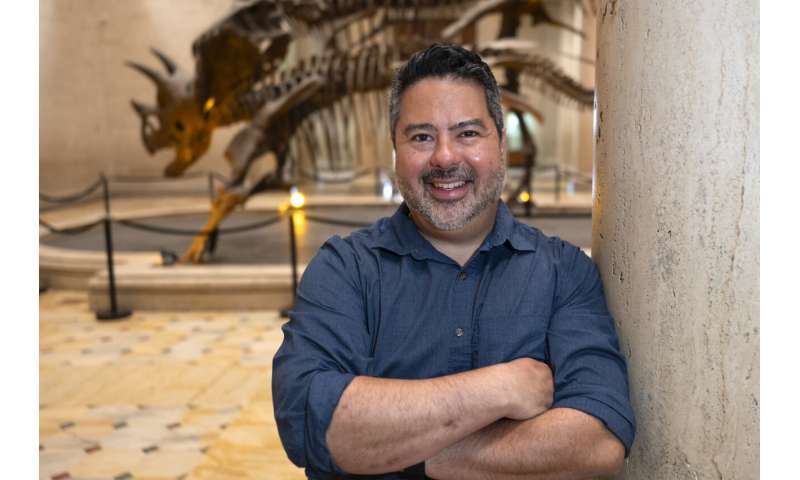
Chris Weisbart, associate vice president of exhibits at the Natural History Museum in Los Angeles, speaks during an interview at the museum Tuesday, July 2, 2024. Los Angeles’ newest resident is big, green and 150 million years old, 75 feet -the tall green dinosaur named Gnatalie (pronounced Natalie) which will be available for public viewing in the fall at the museum. Weisbart said “We want it to be nominated by the people of LA and we want it to express how engaged we are with our communities.” While researchers referred to the fossil as Gnatalie after the swarms of biting mosquitoes that attacked it during excavation, Los Angeles residents confirmed the name earlier this year in a popular vote. Credit: AP Photo/Richard Vogel
-
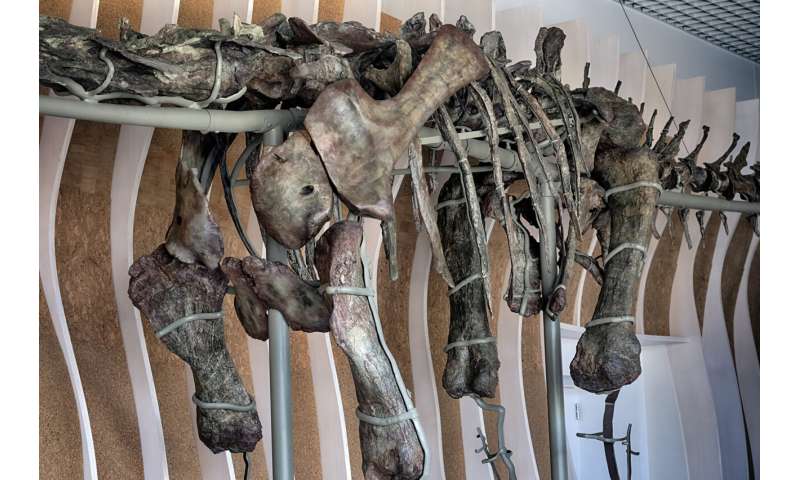
The midsection of a 150-million-year-old dinosaur skeleton is displayed at the Natural History Museum’s new welcome center currently under construction Tuesday, July 2, 2024. Los Angeles’ newest resident is a large, green and the 150-million-year-old, 75-tall green dinosaur named Gnatalie, which will be available for public viewing in the fall at the museum. Research believes that Gnatalie (pronounced Natalie) is a member of a new species of sauropod, a long-necked dinosaur that lived 150 million years ago in the late Jurassic era. Credit: AP Photo/Richard Vogel
-
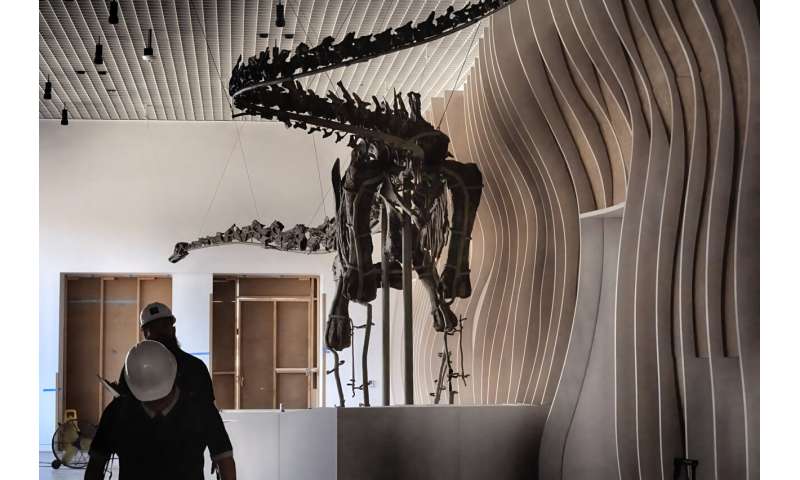
Museum workers walk past a 150-million-year-old dinosaur skeleton on display at the Natural History Museum’s new welcome center currently under construction Tuesday, July 2, 2024. Los Angeles’ newest resident is a large, green and 150-million-year-old, 75-foot-long green dinosaur named Gnatalie (pronounced Natalie) which will be available for public viewing in the fall at the museum. Credit: AP Photo/Richard Vogel
“It’s huge, it really adds to our ability to understand taxonomic diversity … but also anatomical diversity,” Whitlock said.
The dinosaur was named “Gnatalie” last month after the museum asked for a public vote on five choices that included Verdi, a derivative of the Latin word for green; Olive, after the small green fruit that symbolizes peace, joy and strength in many cultures; Esme, short for Esmerelda, which is Spanish for Emerald; and Sage, a green and iconic LA plant also grown in the Natural History Museum’s Nature Gardens.
© 2024 Associated Press. All rights reserved. This material may not be published, transmitted, rewritten or redistributed without permission.
citation: Gnatalie is the only green-boned dinosaur found on the planet. It will appear in LA (2024, July 14) Retrieved July 14, 2024 from https://phys.org/news/2024-07-gnatalie-green-boned-dinosaur-planet.html
This document is subject to copyright. Except for any fair agreement for study or private research purposes, no part may be reproduced without written permission. The content is provided for informational purposes only.